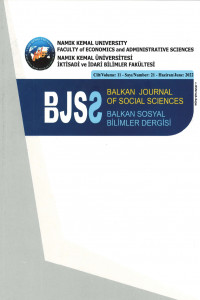Abstract
Dünyada, birçok kişi yaşamına yetecek kadar yiyeceğe ulaşamamaktadır. Dünyadaki yaklaşık olarak dokuz kişiden birisi açtır. Dünyadaki aç insanların büyük çoğunluğu gelişmekte olan ülkelerde yaşamaktadır. Asya, açlığın en çok olduğu bölgedir, kıta toplamının üçte ikisi açlık içindedir. Sahra altı Afrika, en yüksek açlık oranı olan (nüfusun yüzdesi olarak) açlık bölgesidir. Bu bölgede; dört kişiden birisi yetersiz beslenmektedir. Yetersiz beslenme sonucunda, her yıl doğan beş çocuktan birisi hayatını kaybetmektedir. Gelişmekte olan ülkelerde, altı çocuktan biri açlık nedeniyle hayatını kaybetmektedir. Dünya çocuklarının dörtte biri yeterince fiziksel gelişim göstermemektedir. Gelişmekte olan ülkelerde bu oran, üçte bir oranına kadar çıkmaktadır. Her yıl 66 milyon ilkokul çağındaki çocuktan, 23 milyonu sadece Afrika ile gelişmekte olan ülkeler arasında açlık sınıfına katılmaktadır. Dünya Gıda Programı (WFP, World Food Programme), 66 milyon okul çağındaki aç çocuklara ulaşmak için yılda 3.2 milyar ABD dolarına ihtiyaç olduğunu hesaplamıştır.
Keywords
References
- ATB (2019). Dünya'da ve Türkiye'de Açlık Sorunu. (30.07.2019), Retrieved from http://eski.ankaratb.tobb.org.tr/pages.aspx?pageId=1403c660-220c-4b44-a902-656d16cee3ae.
- FAO (2006). The State of Food Insecurity in the World, 2006. Eradicating World Hunger- Taking Stock Ten Years after the World Food Summit. (30.07.2019), Retrieved from https://www.fao.org/publications/card/en/c/aae6300c-600b-5d35-81ef-aa27e287f345/.
- FAO (2010). The State of Food Insecurity in the World, 2010. Addressing Food Insecurity in Protracted Crises. (30.07.2019), Retrieved from https://www.fao.org/publications/card/en/c/0939000e-46d8-5435-9798-68ff849bf29e/#:~:text=This%20year%2C%20The%20State%20of,be%20at%20almost%2040%20percent.
- FAO (2013). The state of food and agriculture 2013: Food Systems for Better Nutrition. (30.07.2019), Retrieved from https://www.fao.org/3/i3300e/i3300e00.htm.
- FAO (2015). 70 Years of FAO (1945-2015). (30.07.2019), Retrieved from https://www.fao.org/publications/card/fr/c/efeddfc5-0be1-4010-8aeb-24e6c1979566/
- FAO (2017). The State of Food Security and Nutrition in the World 2017. Building Resilience for Peace and Food Security. (30.07.2019), Retrieved from http://www.fao.org/state-of-food-security-nutrition/en/
- FAO (2018). The State of Food Security and Nutrition in the World 2018. Building Climate Resilience for Food Security and Nutrition. (30.07.2019), Retrieved from https://www.fao.org/3/i9553en/i9553en.pdf
- Hürriyet. (2019). Dünya Haberleri. (25.07.2019), Retrieved from http://www.hurriyet.com.tr/dunya/bm-raporuna-gore-dunyada-her-9-kisiden-biri-ac-40953309.
- IFPRI (2017). Food Security Definition from the UN’s World Food Program and Hunger, Undernutrition, and Malnutrition from the International Food Policy Research Institute’s Global Hunger Index. (25.07.2019), Retrieved from https://www.ifpri.org/publication/global-hunger-index.
- İnsamer (2019). Dünyada ve Türkiye’de Açlık Sorunu. (20.07.2019), Retrieved from https://insamer.com/tr/dunyada-ve-turkiyede-aclik-sorunu_107.html.
- Roser, M. and Ritchie, H. (2019). Hunger and undernourishment. (05.08.2019), Retrieved from https://ourworldindata.org/hunger-and-undernourishment.
- NRC. (2006). Fluoride in Drinking Water. (05.08.2019), Retrieved from https://www.nap.edu/catalog/11571/fluoride-in-drinking-water-a-scientific-review-of-epas-standards.
- TurkStat-Turkish Statistical Institute. (2019). Gelir ve Yaşam Koşulları Araştırması. (05.08.2019), Retrieved from http://www.tuik.gov.tr/PreHaberBultenleri.do ?id=13594.
- UNICEF (2015). UNICEF Annual Report 2015. (05.08.2019), Retrieved from https://www.unicef.org/reports/unicef-annual-report-2015.
- World Bank Data. (2019). The World Data Bank. (05.08.2019), Retrieved from https://data.worldbank.org/indicator/NY. GNP.MKTP.KD.
- WFP (2019). Ending Hunger. (30.07.2019), Retrieved from https://www1.wfp.org/zero-hunger.
- World Health Organization. (2014). WHA Global Nutrition Targets 2025: Wasting Policy Brief. (30.07.2019), Retrieved from https://www.who.int/publications/i/item/WHO-NMH-NHD-14.2.
- World Hunger. (2018). 2018 World Hunger and Poverty Facts and Statistics. (23.10.2018), Retrieved from https://www.worldhunger.org/world-hunger-and-poverty-facts-and-statistics/#definitions.
Abstract
Many people do not have access to enough food to survive in the world. Approximately one in nine people in the world are hungry. The vast majority of hungry people in the world live in developing countries. Asia is the region with the most hunger, with two-thirds of the continent's total starvation. Sub-Saharan Africa is the region with the highest hunger rate (as a percentage of the population). In this region; One in four people is malnourished. As a result of malnutrition, one in five children born each year dies. In developing countries, one in six children dies from hunger. A quarter of the world's children do not show enough physical development. In developing countries, this rate rises to one third. Of the 66 million primary school-aged children each year, 23 million attend the hunger class between Africa and developing countries alone. The World Food Program (WFP) has calculated that US$3.2 billion per year is needed to reach 66 million starving school-age children.
Keywords
References
- ATB (2019). Dünya'da ve Türkiye'de Açlık Sorunu. (30.07.2019), Retrieved from http://eski.ankaratb.tobb.org.tr/pages.aspx?pageId=1403c660-220c-4b44-a902-656d16cee3ae.
- FAO (2006). The State of Food Insecurity in the World, 2006. Eradicating World Hunger- Taking Stock Ten Years after the World Food Summit. (30.07.2019), Retrieved from https://www.fao.org/publications/card/en/c/aae6300c-600b-5d35-81ef-aa27e287f345/.
- FAO (2010). The State of Food Insecurity in the World, 2010. Addressing Food Insecurity in Protracted Crises. (30.07.2019), Retrieved from https://www.fao.org/publications/card/en/c/0939000e-46d8-5435-9798-68ff849bf29e/#:~:text=This%20year%2C%20The%20State%20of,be%20at%20almost%2040%20percent.
- FAO (2013). The state of food and agriculture 2013: Food Systems for Better Nutrition. (30.07.2019), Retrieved from https://www.fao.org/3/i3300e/i3300e00.htm.
- FAO (2015). 70 Years of FAO (1945-2015). (30.07.2019), Retrieved from https://www.fao.org/publications/card/fr/c/efeddfc5-0be1-4010-8aeb-24e6c1979566/
- FAO (2017). The State of Food Security and Nutrition in the World 2017. Building Resilience for Peace and Food Security. (30.07.2019), Retrieved from http://www.fao.org/state-of-food-security-nutrition/en/
- FAO (2018). The State of Food Security and Nutrition in the World 2018. Building Climate Resilience for Food Security and Nutrition. (30.07.2019), Retrieved from https://www.fao.org/3/i9553en/i9553en.pdf
- Hürriyet. (2019). Dünya Haberleri. (25.07.2019), Retrieved from http://www.hurriyet.com.tr/dunya/bm-raporuna-gore-dunyada-her-9-kisiden-biri-ac-40953309.
- IFPRI (2017). Food Security Definition from the UN’s World Food Program and Hunger, Undernutrition, and Malnutrition from the International Food Policy Research Institute’s Global Hunger Index. (25.07.2019), Retrieved from https://www.ifpri.org/publication/global-hunger-index.
- İnsamer (2019). Dünyada ve Türkiye’de Açlık Sorunu. (20.07.2019), Retrieved from https://insamer.com/tr/dunyada-ve-turkiyede-aclik-sorunu_107.html.
- Roser, M. and Ritchie, H. (2019). Hunger and undernourishment. (05.08.2019), Retrieved from https://ourworldindata.org/hunger-and-undernourishment.
- NRC. (2006). Fluoride in Drinking Water. (05.08.2019), Retrieved from https://www.nap.edu/catalog/11571/fluoride-in-drinking-water-a-scientific-review-of-epas-standards.
- TurkStat-Turkish Statistical Institute. (2019). Gelir ve Yaşam Koşulları Araştırması. (05.08.2019), Retrieved from http://www.tuik.gov.tr/PreHaberBultenleri.do ?id=13594.
- UNICEF (2015). UNICEF Annual Report 2015. (05.08.2019), Retrieved from https://www.unicef.org/reports/unicef-annual-report-2015.
- World Bank Data. (2019). The World Data Bank. (05.08.2019), Retrieved from https://data.worldbank.org/indicator/NY. GNP.MKTP.KD.
- WFP (2019). Ending Hunger. (30.07.2019), Retrieved from https://www1.wfp.org/zero-hunger.
- World Health Organization. (2014). WHA Global Nutrition Targets 2025: Wasting Policy Brief. (30.07.2019), Retrieved from https://www.who.int/publications/i/item/WHO-NMH-NHD-14.2.
- World Hunger. (2018). 2018 World Hunger and Poverty Facts and Statistics. (23.10.2018), Retrieved from https://www.worldhunger.org/world-hunger-and-poverty-facts-and-statistics/#definitions.
Details
| Primary Language | English |
|---|---|
| Subjects | Economics |
| Journal Section | Review Article |
| Authors | |
| Publication Date | July 1, 2022 |
| Acceptance Date | April 29, 2022 |
| Published in Issue | Year 2022 Volume: 11 Issue: 21 |

